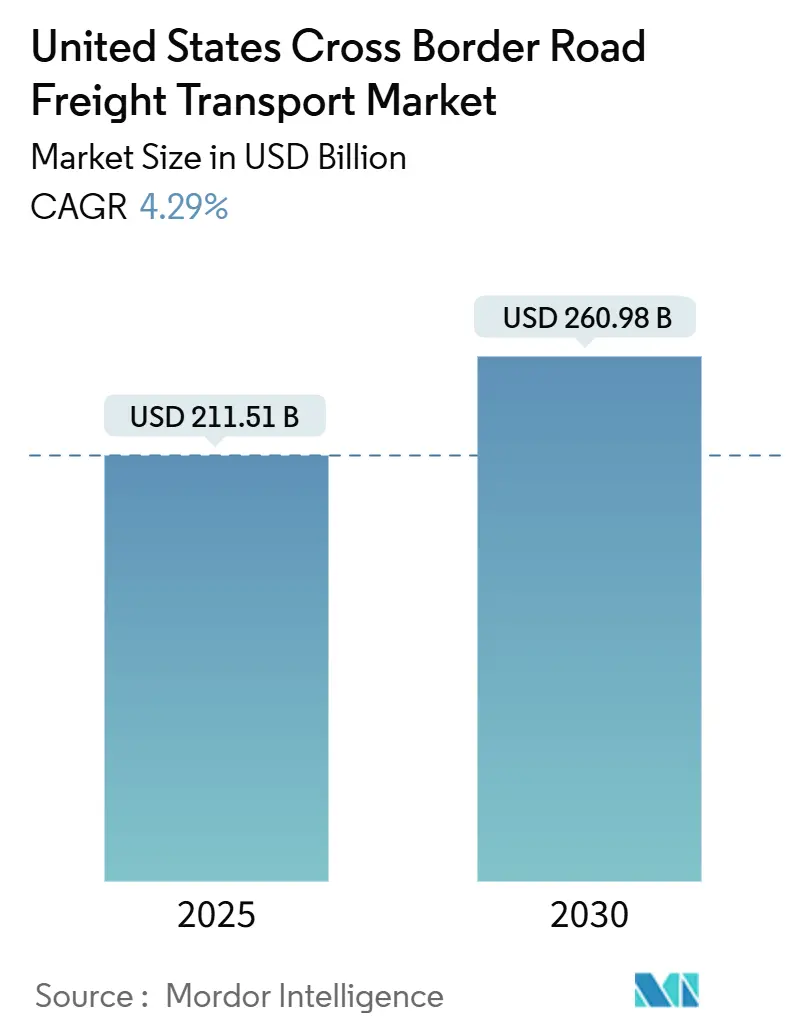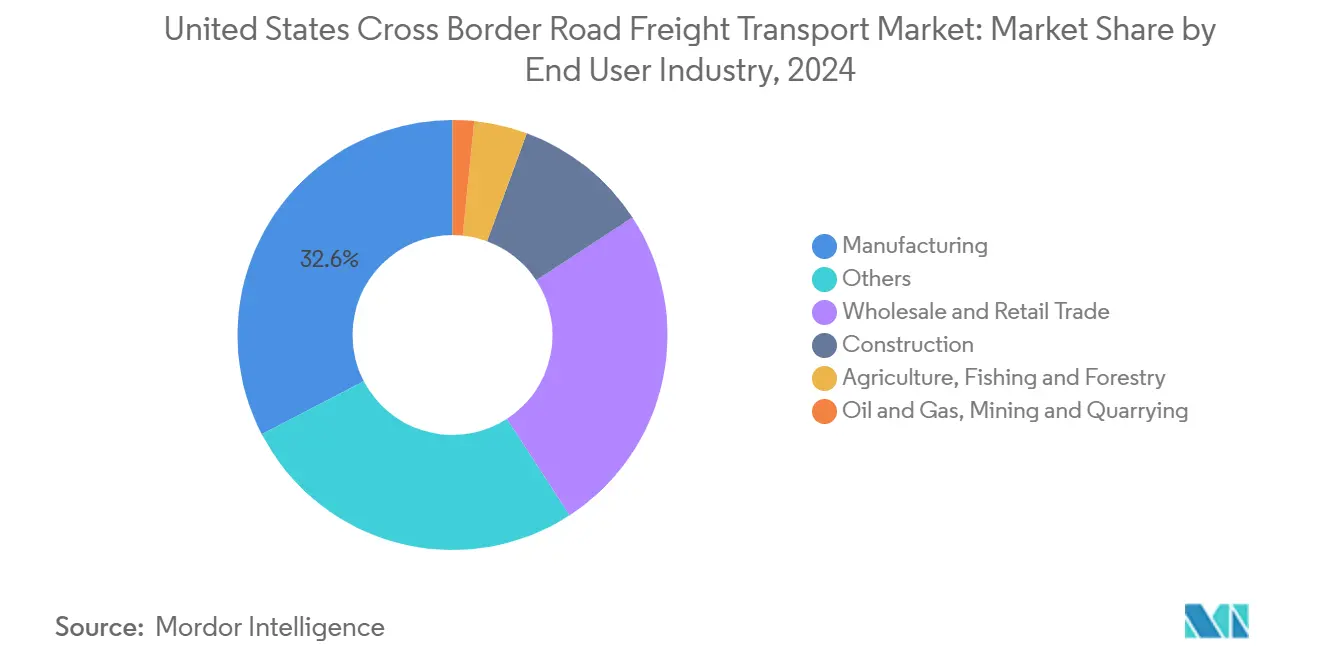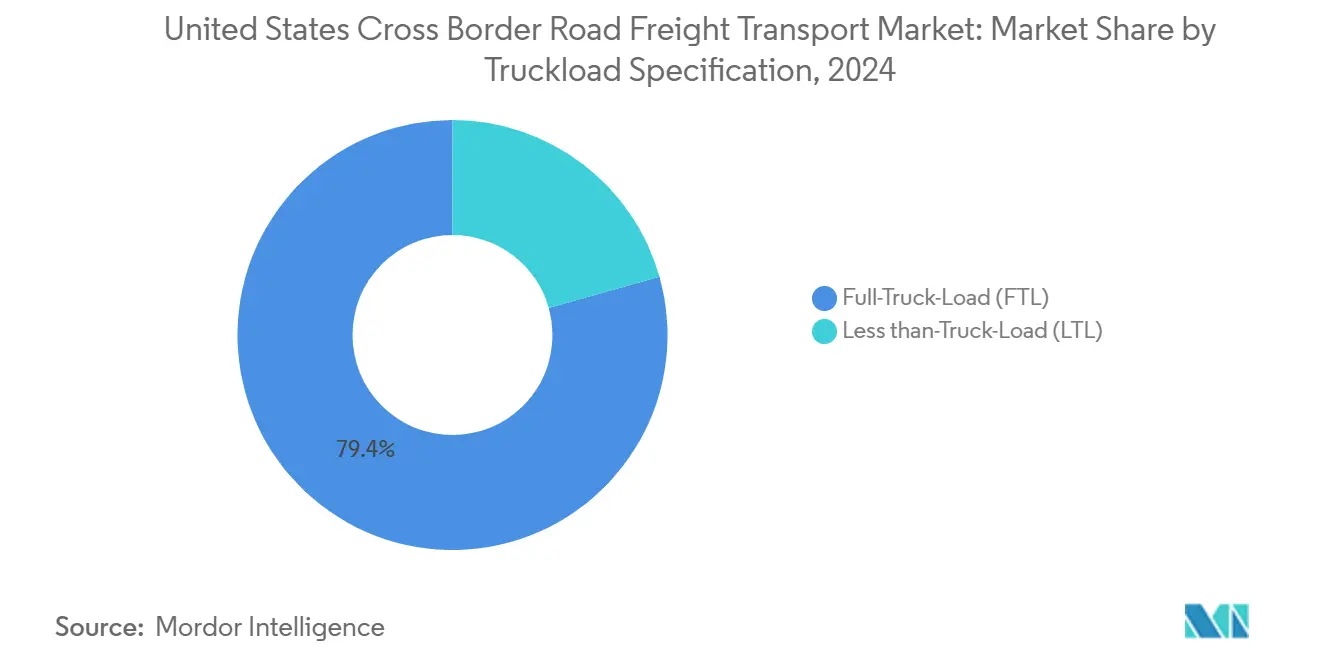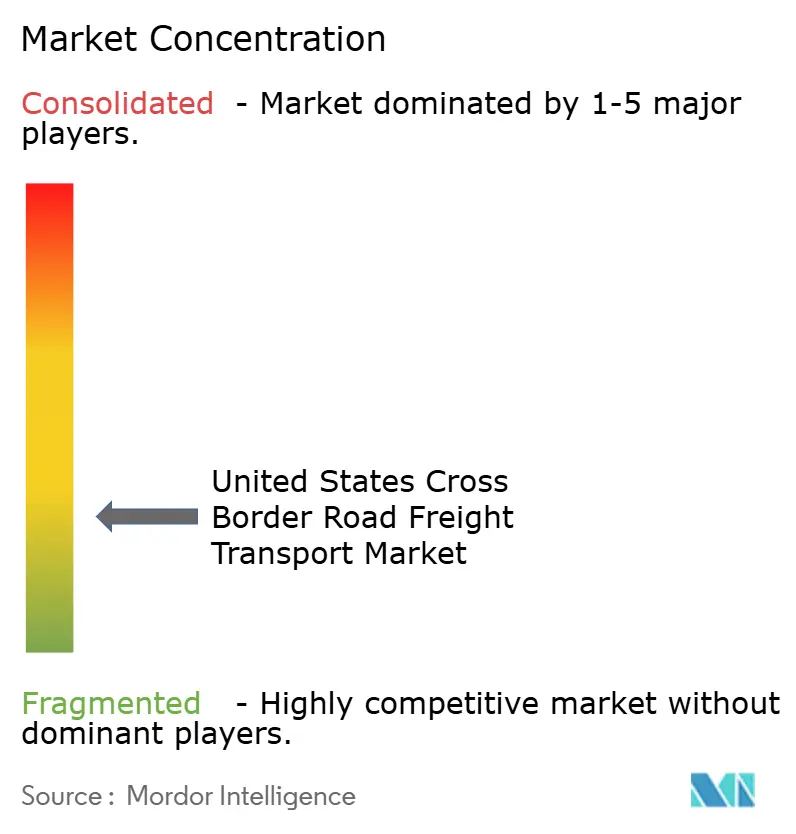
United States Cross Border Road Freight Transport Market Analysis by Mordor Intelligence
The United States cross border road freight transport market size is estimated at USD 211.51 billion in 2025, and is expected to reach USD 260.98 billion by 2030, at a CAGR of 4.29% during the forecast period (2025-2030). Nearshoring within the USMCA trade corridor, sustained e-commerce expansion, and large-scale infrastructure upgrades are reinforcing demand even as tighter security protocols and labor shortages test network agility. Mexico has overtaken China as the United States’ largest trading partner, creating dense south–north truck lanes that now channel more than USD 3 billion in daily commerce, while Canada retains a vital but costlier role due to carbon-pricing regimes. Persistent driver scarcity, widening to a projected 160,000-person deficit by 2032, is pushing rates higher and accelerating technology adoption that boosts equipment utilization and pricing precision. Consolidation among top carriers, exemplified by DSV’s purchase of DB Schenker and Ryder’s acquisition push, is enabling scale efficiencies in cross-border dedicated fleets even as niche operators gain share in temperature-controlled and e-commerce-led LTL lanes. Autonomous truck pilots on the Interstate 45 and Interstate 35 corridors and AI-enabled pricing engines are lowering empty miles and rounding out 24/7 long-haul capacity, placing technology at the heart of competitive advantage.
Key Report Takeaways
- By end user industry, manufacturing led with 32.64% of the United States cross border road freight transport market share in 2024, while wholesale and retail trade is projected to post the fastest 5.07% CAGR between 2025-2030.
- By truckload specification, full-truck-load (FTL) operations held 79.36% of the United States cross border road freight transport market size in 2024 and less than-truck-load (LTL) services are expected to advance at a 5.15% CAGR between 2025 and 2030.
- By containerization, non-containerized freight commanded 85.37% of the revenue share in 2024, whereas containerized flows are slated to grow 4.94% CAGR between 2025-2030.
- By distance, long-haul services represented 69.51% of the revenue share in 2024, yet short-haul lanes are expected to grow at a 5.23% CAGR between 2025-2030.
- By goods configuration, solid goods captured 73.12% share of the market revenue in 2024, while fluid goods are forecast to expand at a 4.86% CAGR between 2025-2030.
- By temperature control, the non-temperature-controlled segment held 94.65% of the market revenue in 2024 as temperature-controlled freight is projected to accelerate at a 5.02% CAGR between 2025-2030.
United States Cross Border Road Freight Transport Market Trends and Insights
Drivers Impact Analysis
| Driver | (~) % Impact on CAGR Forecast | Geographic Relevance | Impact Timeline |
|---|---|---|---|
| USMCA and near-shoring fueling a Mexico–U.S. freight surge | +1.2% | Texas, California, Arizona border states | Medium term (2 – 4 years) |
| Reshoring sparking stronger northbound auto-parts traffic from Mexico | +0.8% | Michigan, Texas, Ohio auto corridors | Medium term (2 – 4 years) |
| E-commerce growth boosting demand for time-definite cross-border LTL | +0.9% | U.S.–Canada and U.S.–Mexico borders | Short term (≤ 2 years) |
| Expanded CTPAT FAST lanes reducing border delays | +0.6% | Laredo, Detroit, Buffalo, Otay Mesa | Short term (≤ 2 years) |
| Autonomous truck trials gaining traction on I‑45 and I‑35 trade routes | +0.4% | Dallas–Houston, Texas corridors | Long term (≥ 4 years) |
| AI-powered pricing platforms quietly reshaping the market | +0.3% | North America-wide | Medium term (2 – 4 years) |
| Source: Mordor Intelligence | |||
USMCA and Near-Shoring Fueling a Mexico-U.S. Freight Surge
USMCA provisions have catalyzed a USD 1.3 trillion trade corridor that funnels manufacturing exports from Mexico to the United States and has already drawn USD 46 billion in new investment commitments through 2027. Monthly truck crossings average 1.5 million units, a 166.3% jump versus pre-pandemic flows, overwhelming legacy border infrastructure and lifting carrier pricing power as northbound industrial freight pushes capacity limits. Demand for industrial space along the Mexican side has doubled since 2019, confirming manufacturers’ preference for proximity over distant Asian supply chains. Automotive OEMs illustrate the multiplier effect: every USD 1 billion poured into Mexican assembly plants triggers sizable localized logistics demand that migrates north, reinforcing the growth arc of the United States cross border road freight transport market.
Reshoring Sparking Stronger Northbound Auto-Parts Traffic from Mexico
Automotive supply chains continue to retool as Asian component makers site new Mexican factories to preserve U.S. market access amid trade frictions, exemplified by a USD 400 million investment by Shanghai Unison in 2024. These additions skew lane balance, with northbound trailers commanding premium spot rates while southbound rates stagnate, complicating asset repositioning and elevating carrier margins on preferred directions. Semiconductor and battery firms mirror this footprint, further amplifying northbound tonnage. Real-time visibility platforms are now indispensable for cargo-theft mitigation and for orchestrating inbound origin docks with U.S. destination plants, sustaining the efficiency of the United States cross border road freight transport market.
E-Commerce Growth Boosting Demand for Time-Definite Cross-Border LTL
Online sales from cross border heavyweights Shein and Temu reached USD 44 billion in 2024, propelling the e-commerce share of U.S. retail toward a 30% threshold by 2030. Parcel-sized, high-velocity orders are fragmenting shipment profiles, moving freight from FTL into LTL networks that prize time-definite delivery and real-time tracking. Industry consolidation is amplifying carrier pricing discipline, and technology-enabled route optimization has already reduced deadhead miles from 35% to 10% for early adopters, bolstering profitability across the United States cross border road freight transport market.
Expanded CTPAT FAST Lanes Reducing Border Delays
Federal investment of USD 134 million in the Otay Mesa upgrade and USD 191 million in the Calexico West expansion has cut average dwell times from up to four hours to roughly 20 minutes. More than 11,400 companies now participate in CTPAT, representing over half of U.S. imports, giving certified carriers expedited processing through FAST channels. The World Trade Bridge in Laredo is adding four new FAST lanes, solidifying the corridor’s role as the busiest commercial gateway and enhancing service reliability for the United States cross border road freight transport market[1]“CTPAT Global Presence Map,” U.S. Customs and Border Protection, cbp.gov.
Restraints Impact Analysis
| Restraint | (≈) % Impact on CAGR Forecast | Geographic Relevance | Impact Timeline |
|---|---|---|---|
| Driver shortages driving up line-haul rates | −0.7% | North America, long-haul lanes | Long term (≥ 4 years) |
| Canadian carbon pricing adding hidden costs for U.S. carriers | −0.3% | U.S.–Canada corridors | Medium term (2 – 4 years) |
| Heightened border security creating unpredictable wait times | −0.4% | U.S.–Mexico and U.S.–Canada crossings | Short term (≤ 2 years) |
| Wildfire-related closures disrupting U.S.–Canada highway routes | −0.2% | British Columbia, Western U.S.–Canada lanes | Short term (≤ 2 years) |
| Source: Mordor Intelligence | |||
Driver Shortages Driving Up Line-Haul Rates
The labor crunch could double to 160,000 vacant seats by 2032 as the cohort aged over 55 exits in greater numbers than new entrants replace them, pushing line-haul rates higher and eroding small-carrier resilience. FMCSA grants worth USD 48 million are widening CDL training pathways, yet cross-border work demands additional security clearances that limit candidate pools. Exemptions allowing learner-permit holders to operate in revenue service signal how urgently fleets must shore up capacity, and this constraint is the largest structural drag on the United States cross border road freight transport market.
Canadian Carbon Pricing Adding Hidden Costs for U.S. Carriers
Canada lifted its federal carbon levy to CAD 80 (USD 60.34) per ton in 2024, inflating diesel prices by 21.39 cents per liter; U.S. fleets running northern lanes report fuel bills climbing 15-20% on Canadian road legs. Administrative compliance, especially for smaller operators, loads further costs onto northbound corridors, dulling rate competitiveness in the United States cross border road freight transport market[2]“How Pollution Pricing Reduces Emissions,” Government of Canada, canada.ca.
Segment Analysis
By End User Industry: Manufacturing Commands Share as Retail Accelerates
Manufacturing generated 32.64% of the United States cross border road freight transport market share in 2024, anchored by complex automotive and industrial supply chains that require dedicated FTL capacity and stringent just-in-time reliability. The United States cross border road freight transport market size tied to manufacturing lanes is projected to expand steadily as OEMs and tier suppliers deepen near-shoring investments, although incremental gains moderate due to commodity price swings affecting metals and plastics. Wholesale and retail trade volumes have begun to rise faster as cross-border e-commerce penetration propels shipment counts; the segment is forecast to log a 5.07% CAGR (2025-2030) as consumer-facing firms press for more frequent, smaller-lot deliveries.
Diversification across electronics, healthcare equipment, and agricultural perishables enriches the shipment mix, calling for wider equipment varieties and bolstering LTL and temperature-controlled sub-markets. Wholesale and retail trade players embrace blockchain-enabled customs filing to compress clearance windows, while auto makers expand digital twin modeling for lane optimization. Together, these shifts reinforce manufacturing’s anchor role yet spotlight retail’s growing pull on carrier network design across the United States cross border road freight transport market.

Note: Segment shares of all individual segments available upon report purchase
By Containerization: Bulk Advantage Persists Amid Intermodal Upswing
Non-containerized freight held 85.37% of the United States cross border road freight transport market share in 2024, powered by bulk commodities and oversized auto components that depend on direct truck service. Time-sensitive manufacturing cargo sidesteps rail handoffs, cementing trucking’s modal advantage despite rising rail competitiveness.
Containerized freight is poised for a 4.94% CAGR (2025-2030) as intermodal services integrate blockchain-supported tracking that slashes document errors and enhances visibility. E-tailers importing fast-moving goods in 40-ft boxes are experimenting with truck-rail transloads along the U.S.–Mexico Gulf corridor, tempering highway lane congestion. Non-containerized dominance will hold through 2030, yet incremental intermodal penetration signals carriers must broaden asset portfolios to capture rising container drayage revenue within the United States cross border road freight transport market.
By Distance: Long Haul Dominates while Short Haul Narrows the Gap
Long-haul moves represented 69.51% of the United States cross border road freight transport market size in 2024, leveraging corridor economies along Interstates 35 and 45 that string together Laredo, Dallas, and Houston at high frequency. Autonomous pilots promise to trim line-haul cost per mile by unlocking continuous equipment use, strengthening long-haul economics even as labor scarcity intensifies.
Short-haul freight is expected to notch a 5.23% CAGR (2025-2030) as omnichannel retailers seed micro-fulfillment hubs near border metro areas, expanding regional loops under 250 miles. Drivers favor same-day home time, helping recruit new entrants and partially offsetting shortages in the United States cross-border road freight transport market. AI route engines that crunch 1,100 variables are improving short-haul asset turns by double digits, further narrowing the historical margin gap with long-haul lanes.
By Truckload Specification: Full-Truck-Load (FTL) Scale Meets Less than-Truck-Load (LTL) Agility
FTL accounted for 79.36% of the United States cross border road freight transport market size in 2024, reflecting high-volume automotive and industrial movements that favor full-truck economics and minimal handling. Yet, LTL is projected to outpace at a 5.15% CAGR (2025-2030) as e-commerce splinters order profiles, compelling carriers to refine hub-and-spoke models and deploy dynamic linehaul scheduling.
Consolidation continues: the bankruptcy of Yellow Corporation opened 10 terminals that Knight-Swift acquired for USD 2.2 million, illustrating how network real estate can swing quickly to remaining incumbents and fortify their share within the United States cross border road freight transport market. AI-driven load pairing is narrowing empty-mile gaps, and the new capacity discipline is enabling LTL carriers to levy surcharges that outstrip FTL rate growth. While FTL retains volume dominance, LTL’s technology-backed agility is altering how shippers think about cost-to-serve and transit-time trade-offs on cross border lanes.

By Goods Configuration: Solid Goods Prevail yet Fluid Goods Edge Up
Solid goods comprised 73.12% of the United States cross border road freight transport market share in 2024, led by auto parts, machinery, and packaged consumer goods that flow through dedicated industrial corridors. Packaging standardization accelerates dock throughput, holding down dwell charges.
Fluid goods are set for a 4.86% CAGR (2025-2030) as chemical and refined-product sectors leverage trucking to bypass pipeline bottlenecks and balance regional inventories. Specialized tank equipment and hazmat compliance elevate barriers to entry, affording established fluid carriers premium rates. Both configurations are deploying IoT sensor arrays for in-transit condition monitoring, enhancing safety and bolstering trust across the United States cross border road freight transport market.
By Temperature Control: Cold Chain Gains Share from Ambient Freight
Non-temperature controlled cargo dominated at 94.65% of the United States cross border road freight transport market size in 2024, mirroring the industrial profile of cross-border trade. Regulatory tightening on food and pharma logistics will, however, boost temperature controlled volumes at a CAGR of 5.02% between 2025-2030.
Pharmaceutical shippers are mandating real-time temperature telemetry that integrates with customs portals to verify chain-of-custody during clearance, rewarding fleets equipped with smart reefers. Food exporters from Mexico’s Bajio region to U.S. distribution centers are likewise driving reefer demand, shifting project bids toward higher-margin cold chain lanes inside the United States cross border road freight transport market.
Geography Analysis
Southern corridors have become the growth fulcrum for the United States cross border road freight transport market, funneling 72.2% of surface trade value with Mexico via trucking and generating more than USD 3 billion of daily bilateral commerce. Laredo alone processed a significant slice of the USD 283 billion of Mexican imports handled by U.S. customs in fiscal 2023, and infrastructure spending exceeding USD 1.5 billion, including the USD 150 million Otay Mesa East build-out, targets congestion relief that could push throughput capacity up by mid-decade. Technology pilots concentrate here as well: autonomous rigs run the Dallas-Houston loop without driver intervention for stretches exceeding 200 miles, demonstrating readiness for eventual south-north scaling.
The northern border retains strategic heft despite cost headwinds. Canada’s carbon levy lifts diesel outlays, and spot rate volatility has risen since 2024, yet trucking still accounted for 60.1% of the USD 77 billion in bilateral surface trade recorded in January 2023. Expansion of the Pacific Highway crossing will add four inspection lanes by 2026, echoing FAST-lane projects at southern gateways. Seasonal wildfires, however, disrupt the British Columbia interior[3]“Drivers Warned to Prepare for Highway Closures,” British Columbia Ministry of Transportation, news.gov.bc.ca, prompting carriers to build dynamic detour protocols into operating plans and safeguarding service levels in the United States cross-border road freight transport market.
Technology adoption differs by corridor. Blockchain document exchanges now shave hours off Mexican clearances, yet remain nascent on Canadian lanes where bilingual regulatory harmonization is ongoing. Across both borders, AI-driven dispatch dashboards harmonize driver availability, traffic, and customs windows to maximize tractor productivity. This trinational lattice of high-capacity highways, digitized processes, and evolving security regimes frames the geographic complexity and growth runway of the United States cross border road freight transport market.
Competitive Landscape
Large-scale mergers continue to redraw competitive lines. DSV’s EUR 14.3 billion (USD 15.78 billion) acquisition of DB Schenker vaulted the Danish integrator to the top tier with 147,000 employees and a road network that blankets 90 countries, signaling a new scale benchmark that rivals must match. Ryder’s USD 302 million purchase of Cardinal Logistics added nearly 3,000 power units and pushed dedicated revenues up 46% in the latest quarter, while Schneider deepened contract carriage reach with its USD 390 million Cowan Systems deal. These moves illustrate how capital-heavy platforms are courting end-to-end control to secure cross border volumes against tighter capacity and rising compliance costs.
Mid-cap carriers are responding through targeted asset buys and technology upgrades. Knight-Swift snapped up 10 former Yellow terminals for USD 2.2 million and an additional Los Angeles fleet to solidify Southwest corridor density, then rolled out AI dispatch tools that trimmed empty miles and lifted tractor revenue. ArcBest invested in autonomous forklifts and network redesigns that raised 2024 productivity despite soft industrial demand. Niche specialists in hazmat, cold chain, and cross border e-commerce fulfilment are also leveraging digital freight platforms for real-time visibility, allowing them to charge service premiums without matching fleet scale.
Technology is now the primary differentiator across all tiers. AI-driven pricing engines deliver 10-17% revenue gains per truck[4]“Integrating Blockchain Technology with Telematics,” IJGIS, ijgis.pubpub.org, while autonomous pilots on Interstate 45 and Interstate 35 signal a path to 24/7 asset utilization that could blunt labor shortages. CTPAT and FAST certifications cover more than half of U.S. imports, making security compliance a prerequisite for lucrative shipper contracts. Overall, the top five operators control roughly 45-50% of cross border capacity, translating into a moderate concentration that still leaves room for agile regionals to thrive in specialized niches of the United States cross border road freight transport market.
United States Cross Border Road Freight Transport Industry Leaders
-
Schneider National, Inc.
-
C.H. Robinson Worldwide, Inc.
-
J.B. Hunt Transport, Inc.
-
Knight-Swift Transportation Holdings, Inc.
-
United Parcel Service of America, Inc. (UPS)
- *Disclaimer: Major Players sorted in no particular order



Recent Industry Developments
- March 2025: Ryder signaled intent for additional dedicated carrier purchases after the USD 302 million Cardinal Logistics deal lifted Q4 dedicated revenue 46% to USD 472 million.
- February 2025: ArcBest reported USD 4.2 billion in 2024 revenue and deployed autonomous forklifts plus AI filters to boost network productivity.
- January 2025: Knight-Swift bought 10 former Yellow Corp. terminals for USD 2.2 million to deepen LTL reach across six states.
- August 2024: C.H. Robinson agreed to sell its European surface unit to sennder to focus capital on North American truckload and LTL.
United States Cross Border Road Freight Transport Market Report Scope
Cross-border road freight transport means the transport of freight in the course of an industry, trade, or business, to or from the Republic, crossing or intending to cross its borders into the territory of another state.
The United States Cross-border Road Freight Transport Market is segmented by Service (Full Truck Load, Less-than-Truckload, and Courier, Express, Parcel), and by End-user (Manufacturing and Automotive, Oil and Gas, Mining, and Quarrying, Agriculture, Fishing and Forestry, Construction, Distributive Trade, Healthcare and Pharmaceutical, and Other End Users). The report offers market sizes and forecasts for all the above segments in value (USD billion).
| Agriculture, Fishing, and Forestry |
| Construction |
| Manufacturing |
| Oil and Gas, Mining and Quarrying |
| Wholesale and Retail Trade |
| Others |
| Full-Truck-Load (FTL) |
| Less than-Truck-Load (LTL) |
| Containerized |
| Non-Containerized |
| Long Haul |
| Short Haul |
| Fluid Goods |
| Solid Goods |
| Non-Temperature Controlled |
| Temperature Controlled |
| End User Industry | Agriculture, Fishing, and Forestry |
| Construction | |
| Manufacturing | |
| Oil and Gas, Mining and Quarrying | |
| Wholesale and Retail Trade | |
| Others | |
| Truckload Specification | Full-Truck-Load (FTL) |
| Less than-Truck-Load (LTL) | |
| Containerization | Containerized |
| Non-Containerized | |
| Distance | Long Haul |
| Short Haul | |
| Goods Configuration | Fluid Goods |
| Solid Goods | |
| Temperature Control | Non-Temperature Controlled |
| Temperature Controlled |


Key Questions Answered in the Report
What is the current value of United States cross border road freight with Mexico and Canada?
The market is valued at USD 211.51 billion in 2025 and is expected to climb to USD 260.98 billion by 2030.
Which shipper segment is growing fastest?
Wholesale and retail trade freight is projected to rise at a 5.07% CAGR between 2025 and 2030, powered by e-commerce.
How severe is the truck-driver shortage?
The shortfall stands near 80,000 drivers in 2025 and could double to 160,000 by 2032, putting upward pressure on rates.
What share of traffic uses long-haul lanes?
Long-haul moves account for 69.51% of all cross-border road freight value in 2024, reflecting the dominance of major U.S.–Mexico and U.S.–Canada corridors.
How fast is containerized cross-border freight growing?
Containerized volumes are forecast to expand at a 4.94% CAGR between 2025-2030 as shippers seek intermodal savings and better visibility.
Which technologies are reshaping competition?
AI-based pricing, real-time visibility platforms, and autonomous truck pilots on Texas corridors are boosting utilization and compressing transit times.
Page last updated on:







